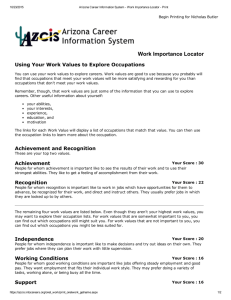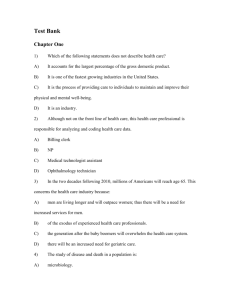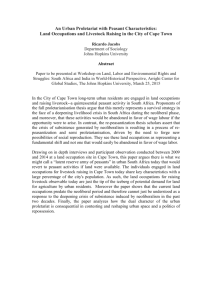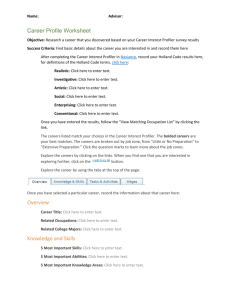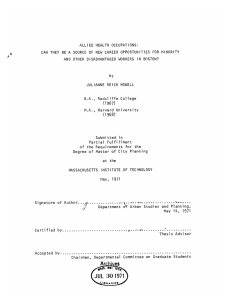classes/nsg101/Unit II Letter B/Critical Thinking Exercise
advertisement
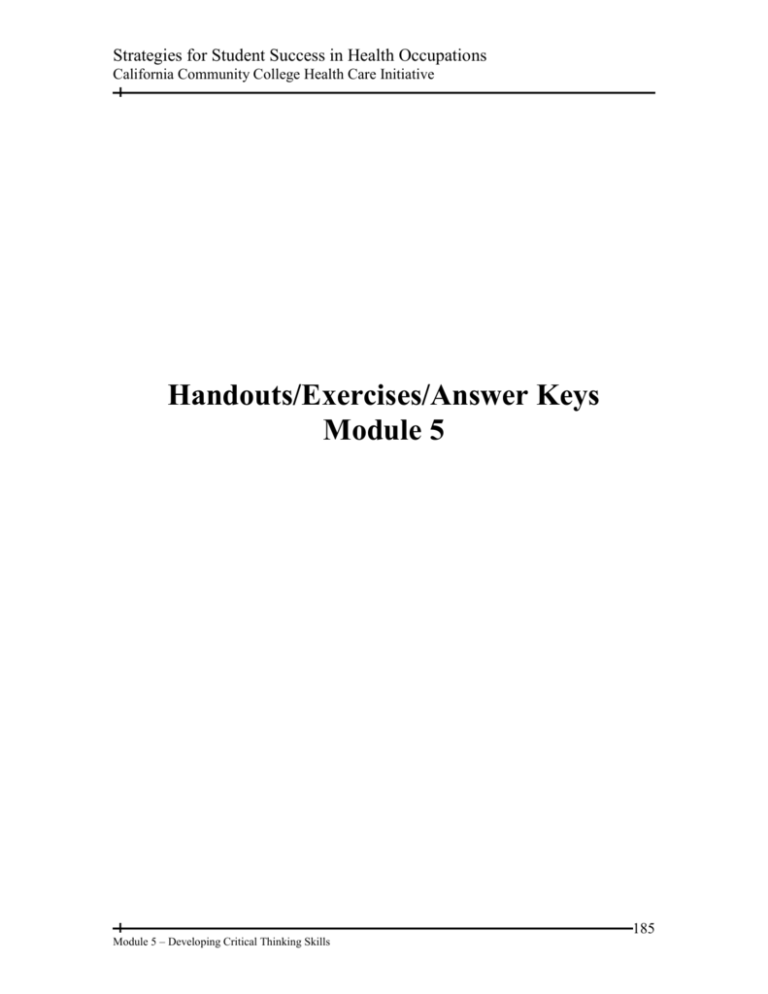
Strategies for Student Success in Health Occupations California Community College Health Care Initiative Handouts/Exercises/Answer Keys Module 5 Module 5 – Developing Critical Thinking Skills 185 Strategies for Student Success in Health Occupations Exercise 5.1 Page 1 of 2 California Community College Health Care Initiative Categorization Activity Directions: Using the words below, categorize systematically for more efficient recall: Car, train, fork, plate, apple, spoon, orange, airplane, cup, banana, bicycle, watermelon What processes did you use? List all the possible options available to you? What diagrams could you use? Car Train Airplane Bicycle Fork Plate Spoon Cup Apple Orange Banana Watermelon This simple chart categorizes the twelve words into three categories: 1. Transportation 2. Things to use when eating or drinking 3. Fruits Car Train Airplane Bicycle Fruits Orange Apple Banana Watermelon Fork Plate Spoon Cup Transportation Eating/Drinking Exercise 5.1 Page 2 of 2 Module 5 – Developing Critical Thinking Skills 186 Strategies for Student Success in Health Occupations California Community College Health Care Initiative Categorization Activity Directions: Using the words below, categorize systematically for more efficient recall: Television, blood pressure cuff, calendar, highlighter, computer, thermometer, radio, back pack, stethoscope, plasma screen, scale, CD-DVD player Words: Words: Words: Exercise 5.2 Module 5 – Developing Critical Thinking Skills 187 Strategies for Student Success in Health Occupations California Community College Health Care Initiative Reflection, Analysis, & Categorization Exercise Frequently, people in health occupations encounter people with pain. This pain can be acute or chronic, mild or severe, brief or continuous, physical or psychological. Reflect on the following phrase for a few minutes. “Pain is inevitable, but misery is optional.” Directions: 1. Reflect on and analyze the above statement from the following perspectives. What do you think this phrase means? Ask your family members and friends what they think this phrase means. Then, branch out and ask at least 15 people or more, representing different ages, genders, occupations (including clergy), ethnic backgrounds, educational backgrounds, social status, state of wellness, etc. 2. Categorize the groups and analyze the similarities and differences among the meanings. Identify the commonalities among the groups. 3. Represent your findings graphically, in a chart, diagram, concept map, or drawing to discuss in class. Exercise 5.3 Source: Adapted from: Smith-Stoner, M. Critical Thinking Activities for Nursing. Lippincott. 1999 Module 5 – Developing Critical Thinking Skills 188 Strategies for Student Success in Health Occupations California Community College Health Care Initiative Examples of Critical Thinking Children are naturals at reading body language and facial expressions. Example: You are a student with a test in the morning. Your partner promised to get your child ready for bed and was called away by a friend who needed a ride home. You are bathing your child hurriedly when they ask, “Mommy, are you mad at me?” Surprised, you answer “Of course not! Why do you think that?” The child answers, “Well, you sure wash mad tonight.” Example: You are working in an out patient clinic and greet a patient in the waiting room. On your way to the examining room, you ask, “How are you today?” The patient answers in a low tone of voice, “Fine.” 1. Do you take her at her word and report that she feels fine today? 2. Do you ask, “Why are you here, then?” 3. What other possible responses are appropriate in the situation? You notice that the patient’s eyes are red and puffy and her nose is red. 1. What are the possible causes of her symptoms? 2. What additional information do you need? 3. What are your preliminary conclusions? How will you validate them? 4. Discuss examples from your own life that demonstrate when you used critical thinking skills. Exercise 5.4 Module 5 – Developing Critical Thinking Skills 189 Strategies for Student Success in Health Occupations California Community College Health Care Initiative Autobiographical Exercise: Self-regulation Directions: Choose an example from your own life where you think you used critical thinking. This could involve a time when you questioned assumptions about the way you typically thought or acted in some area of your life. Or it could be a time when you acted or thought in new ways. This episode may have caused you to think about the flow or misuse of power in your life. It may have alerted you to beliefs, attitudes or actions that you held that were interfering with you achieving your goals. Spend about 15 minutes making written notes about what happened. Be sure to include the questions below in your description. 1. Triggers: What were the circumstances or situations that triggered your critical thinking? 2. Resources: As you worked through the situation, what were the resources (human and material) that were the most useful? 3. Process: a. What were the emotional highs and lows of the process? b. What barriers and hindrances did you experience? (‘shoulds’, negative self-talk, cultural considerations, distractions, etc.) c. How did you work through them? 4. Consequences: a. What happened as a result of this episode? b. Did you permanently change some aspect of the situation or yourself? c. Did things stay the same, other than your heightened awareness? d. Did you wish it had never happened? e. Was the process worthwhile? f. Did you gain any self-knowledge? Source: Adapted from: Brookfield, Stephen. Facilitating Adult Learning and Developing Critical Thinking. Health Occupations Institute. March 2003. Module 5 – Developing Critical Thinking Skills 190 Handout 5.1 Strategies for Student Success in Health Occupations California Community College Health Care Initiative Interrelationships of Critical Thinking, Problem Solving & Decision Making Problem Solving THINKING PROCESSES Critical Thinking Skills Decision Making Interpretation Analysis Self-regulation Inference Evaluation Explanation Strategic Planning Source: Adapted from: Katz, et al. Keys to Nursing Success. Prentice Hall. 2001 191 Module 5-Developing Critical Thinking Skills Strategies for Student Success in Health Occupations Exercise 5.5 California Community College Health Care Initiative Critical Thinking Exercise – Nursing #1 You are a nursing student living with five other students in a large house. Each has their own room, and share bathroom and kitchen facilities. While five of you are having dinner together, someone asks if anyone has seen the sixth student. It becomes apparent that none of the students have seen him for a couple of days, but his bicycle is locked at the rear of the house. You go to his room and knock on the door, but there is no verbal response, although you do hear movement in the room. The group decides to locate the extra key and investigate. They find their housemate sitting on the floor in the corner of his room. The odor of urine is strong and the room is a mess. The young man is quiet, but has a look of terror on his face. As you approach, he tells you to leave him alone or you will regret it. Directions: Write your responses to the following questions and prepare to discuss in class. 1. List the questions that come to mind in reviewing the above situation. 2. Determine the relevance of the questions to the situation facing you at this point in time. 3. Is there any other information that you must have before acting in this situation? 4. List the possible causes for his behavior. 5. List the possible options to consider in dealing with this situation. 6. Prioritize the options in dealing with this situation. Discussion Topics: 1. What assumptions were used in determining your conclusions about an action plan in this situation? Were these assumptions a hindrance or an effective tool in reaching preliminary conclusions? 2. Were any biases apparent in discussing this situation? How are unknown biases detrimental to resolving such a situation? 3. What attitudes are apparent in discussing this situation? How do attitudes impact Answermental Key 5.5 our understanding, assessment and resolution of situations involving Page 1 of 2 health issues? 192 Module 5-Developing Critical Thinking Skills Strategies for Student Success in Health Occupations California Community College Health Care Initiative Exercise 5.6 Critical Thinking Exercise – Nursing #2 Directions: Write your responses to the following questions and prepare to discuss in class. You are caring for a 30 year-old Hispanic male with a long-term partner and two small children, who was admitted to the sub-acute rehabilitation unit in a vegetative state following a ruptured brain aneurysm four months ago. He has not regained consciousness since his “stroke” and has minimal brain activity documented by EEG tracings. He has no response to voice, sight or pain and no gag or swallow reflex. He previously expressed his wishes to his partner about meaningful life telling her that he would not want to be kept alive if he could not participate in life. Unfortunately, he never put these wishes in an Advance Directive and has not discussed his wishes with his parents, who are devout Catholics. A conference was held with his parents and his partner to discuss withdrawing tube feedings and fluids. His parents are very upset and direct their anger to his partner and the nursing staff. The father quotes the commandment “thou shalt not kill” and believes that withdrawing food and fluids would be murder. The mother expresses anger with the medical staff saying that “medical technology has interfered with God’s plan” and there is no choice except to continue with the treatment. His partner, who is 4 ½ months pregnant only cries and says everything is her fault. Questions: 1. Who has the legal right to make decisions about his care? 2. How would the situation have changed if he had signed an Advance Directive and shared it with members of his family? 3. What assumptions do you have about this type of situation? Put yourself in the position of people in the situation (partner, father, mother) and respond to the situation from their point of view. What would your decision be if you were the partner? mother? father? 4. Discuss the situation with another person who has a different religious, spiritual or cultural frame of reference. What were the outcomes of the discussion? What were the similarities? What were the differences? How would you resolve the issues while respecting each person’s beliefs? 5. What other health care professionals would you use as resources in this situation? 6. List three possible options for this family to come to resolution on the issues in this case? 193 Module 5-Developing Critical Thinking Skills

